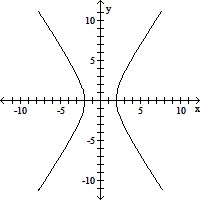Determine whether the graph is that of a function. If it is, use the graph to find its domain and range, the intercepts, if any, and any symmetry with respect to the x-axis, the y-axis, or the origin.
A. function
domain: all real numbers
range: {y|y ? -2 or y ? 2}
intercepts: (-2, 0), (2, 0)
symmetry: y-axis
B. function
domain: {x|x ? -2 or x ? 2}
range: all real numbers
intercepts: (-2, 0), (2, 0)
symmetry: x-axis, y-axis, origin
C. function
domain: {x|-2 ? x ? 2}
range: all real numbers
intercepts: (-2, 0), (2, 0)
symmetry: x-axis, y-axis
D. not a function
Answer: D
You might also like to view...
Solve triangle ABC. If necessary, round the answer to the nearest tenth.B = 30.9°, C = 104.8°, b = 16.1 centimeters
A. A = 44.3°, a = 23.90 cm, c = 32.30 cm B. A = 42.3°, a = 30.3 cm, c = 21.9 cm C. A = 42.3°, a = 32.30 cm, c = 23.90 cm D. A = 44.3°, a = 21.9 cm, c = 30.3 cm
Simplify.If Q(x) = 2x2 - 2x - 8, find Q(-2).
A. -4 B. -12 C. -20 D. 4
Find the specified vector or scalar.v = -7i + 3j; Find  .
.
A. -10
B. 20
C. 10
D. 20i
Find all points (x, y) where  has a possible relative maximum or minimum. Use the second-derivative test to determine, if possible, the nature of f(x, y) at each of these points.
has a possible relative maximum or minimum. Use the second-derivative test to determine, if possible, the nature of f(x, y) at each of these points.
A. (0, 0) gives a relative minimum point B. (0, 1) gives a relative maximum point C. (0, 0) gives a relative maximum point D. (0, 1) gives a relative minimum point